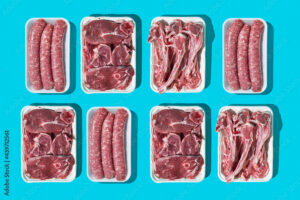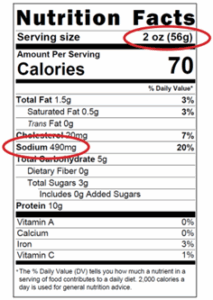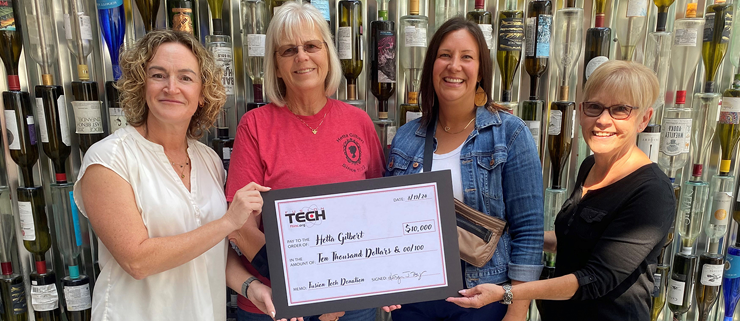Last month we discussed how to break down and interpret the ingredient statement of a Honey Ham with Natural Juices. In this blog post we will learn how to generalize the information on the Nutrition Facts Panel (NFP) and how it correlates to the Ingredient Statement. In the end, we’ll review an example formulation based on all the information available.
The label we looked at last month was the following:
Honey Ham With Natural Juices
Cured with Water, Honey, Dextrose, Contains 2% or Less of: Salt, Potassium Lactate, Sodium Phosphates, Sodium Diacetate, Sodium Erythorbate, Sodium Nitrite.
When evaluating the Nutrition Facts Panel of a product, there are five essential things to look at to properly determine a starting formulation:
- Serving Size
- Total Fat
- Sodium
- Total Carbohydrate (Total Sugars)
- Protein
Interpreting the Nutrition Facts
The serving size is expressed in ounces and grams. This gives the starting point of calculating the percentages of some of the key components of the formulation. The Total Fat provides information on the meat block regardless of the product being produced. This includes not only hams, but also smoked sausages where multiple meat trimmings or cuts are used to create the meat block. Next, the Sodium determines the amount of Salt needed. Total Carbohydrates or Total Sugars help with the amount of Sugar and, in the case of Honey Ham, the total amount of Honey and Sugar combined to meet the regulation. Finally, the Protein content tells us the level of injection we’ll need to target.
The numbers listed on the Nutrition Facts Panels are rounded and the USDA allows a 20% ± variance of the data provided. This will give an approximate range that the formulation could be.
The Meat Block
Higher quality hams such as Natural Juices will typically be produced with either all insides, all outsides, or a combination of both ham muscles. This would depend on how you purchase your ham muscles. Many companies purchase the whole ham and distribute the muscles to various products based on the quality of the ham produced or availability of the muscles. Next, the physical evaluation is important to know if a small amount of ground shank or ham trimmings should be added. Adding a small amount (5%) will help lower the meat cost and improve margin, improve the muscle pieces binding together, and increase the yield of the product without affecting the quality of the ham.
Ingredient Statement
As previously mentioned in Part Two, for a product to be labeled as Honey Ham, the minimum amount of Honey must be at least 3% of the formulation and the additional Sugars cannot exceed 50% of the amount of Honey. The amount of Honey and Dextrose can be calculated from the NFP. There are three grams of total Sugars per 56g serving in the NFP listed below so the calculation would be 3 / 56 x 100 = 5.36%. This falls in the 2.5g (4.5%) – 3.49g (6.2%) based on the ±20% variance the USDA allows on the NFP.

If the ingredient statement is taken verbatim, the Honey will need to be formulated at 4.02% and the Dextrose at 2.01%. This falls within the 4.5% – 6.2% range based on the 3g (5.36%) per serving of Sugar.
 Calculating the Necessary Sodium
Calculating the Necessary Sodium
The next important part of the NFP is the amount of Sodium present. As mentioned in last month’s blog, the free added Salt, in the form of Sodium chloride, contributes most of the Sodium seen in the NFP. Many other ingredients within the ingredient statement contain Sodium, but they do not contribute a significant amount of the Sodium present in the product.
As mentioned last month, there are multiple ways to calculate the amount of Salt needed to add. The quickest and easiest way to calculate it is to take the amount of Sodium and multiply it by 2.5 then divide by 1000. This is the conversion factor from Sodium to Salt. The calculation is the following: 490 X 2.5 = 1,225 / 1000 = 1.225%. To make things easier, one can round up to 1.25% as a starting point. Keep in mind the serving size of Sodium needs to be at 2oz (56g) for this calculation to be accurate. For example, if the serving size is 1oz (28g) or 3oz (84g), the numbers need to be converted to 2oz (56g).
Now let’s return to looking at a Honey Ham with Natural Juices formulation based on all the data we have available.
Honey Ham With Natural Juices
Cured with Water, Honey, Dextrose, Contains 2% or Less of: Salt, Potassium Lactate, Sodium Phosphates, Sodium Diacetate, Sodium Erythorbate, Sodium Nitrite.
With a “natural juices” ham stuffed into a stocking net, a good starting injection percentage should be around 30% of the green weight. This may need to be adjusted based on the final PFF value obtained from the initial samples created.
| Meat | % Product | % Green | |
| Ham Insides | 73.077 | 95.000 | |
| Ground Pork Shank | 5.00% | 3.846 | 5.000 |
| TOTAL MEAT | 76.923 | 100.00 | |
| Ingredients (In order of addition) | |||
| Water | 10.441 | 13.574 | |
| % water as ice | 10% | 1.160 | 1.508 |
| Sodium Phosphate | 0.350 | 0.455 | |
| Salt | 1.250 | 1.625 | |
| Dextrose | 2.010 | 2.613 | |
| Honey | 4.020 | 5.225 | |
| Potassium Lactate/Sodium Diacetate | 3.570 | 4.641 | |
| Sodium Nitrite Blend | 6.25% | 0.234 | 0.304 |
| Sodium Erythorbate | 0.042 | 0.054 | |
| TOTAL BRINE | 23.077 | 30.000 |
Starting off with the meat block, we utilize ham insides along with 5% ground shank meat. The addition of ground shank meat helps reduce the meat cost and helps with extracting more Protein with shorter tumble times to help the muscles to bind together better. However, the ground shank should only be added during the last 15 minutes of the tumbling process to allow the ingredients to better distribute within the whole muscles, to not be absorbed, and held by the ground shank meat.
Impacts and Purposes of Sodium
Let’s continue down the formulation into the ingredients. Next there’s Sodium Phosphate. The USDA’s regulation only allows up to 0.5% in the formulation, but it is not necessary to formulate this high with a lower injection percentage rate due to texture and flavor issues that may be observed. A recommended starting amount of Sodium Phosphate in a natural juice ham is 0.35%. It is best to use a blended Phosphate and not a Sodium Tripolyphosphate (STPP) due to its improved functionality vs the STPP.
Next is Salt, which was calculated earlier to be at 1.25%. When looking at the Honey and Dextrose amounts, there are two ways to look at this. The first is exactly how it is written in the ingredient statement, and the other is to determine the amounts needed based on the remaining ingredients within the formulation. Based on the remaining ingredient levels, the required amount of Honey will be at 4.02% and the Dextrose to be at 2.01%. The next portion would be the Potassium Lactate and Sodium Diacetate blend. As mentioned earlier, this is typically formulated to be 56% Potassium Lactate, 4% Sodium Diacetate, and 40% Water. Based on these numbers we can maximize this amount to 3.57% and keep the Potassium Lactate at 2% to give the greatest shelf-life to the product. One thing to note is to use an ultra-purified Potassium Lactate to give all the benefits of the ingredient while reducing the bitter flavors Potassium is known for.
Types of Sodium
Now the curing ingredients are added last with Sodium Nitrite and Sodium Erythorbate. The USDA maximum allowed amounts are 200ppm for Sodium Nitrite and 547ppm for Sodium Erythorbate. However, it is best to formulate approximately 190ppm and 540ppm respectively. This will give the product the best color development, color stability, and food safety over the course of the shelf-life while providing the processor with a little breathing room for errors during the weighing of the ingredient and slight over pumping that may occur. This Sodium Nitrite blend is at 6.25% which is an industry standard for most cure blends. The calculation to check the ppm for Sodium Nitrite and Sodium Erythorbate is the following:
lb nitrite x 0.0625 x % pump x 1,000,000 = ppm
lb pickle
lb erythorbate x % pump x 1,000,000 = ppm
lb pickle
One Last Ingredient
After all the ingredients are added up, the remaining amount to reach 30% is Water. One important step to consider is adding a little ice as part of the Water formulation to keep the brines cold to aid in the process. This would likely need to be adjusted between the summer and winter months when the ground Water temperature changes.
Other Resources
This is just one method to determine how to reverse engineer a product in the marketplace, and can be used in other products as well. One very helpful resource to understand is the “Process Inspectors Calculations Handbook” on how to properly calculate the restricted ingredients found in many meat products.
If you have any questions, please contact one of our Food Scientists / Applications Specialists to better assist you in any of your equipment or formulation needs!
Check out the first two articles of this series: Part One, Part Two




